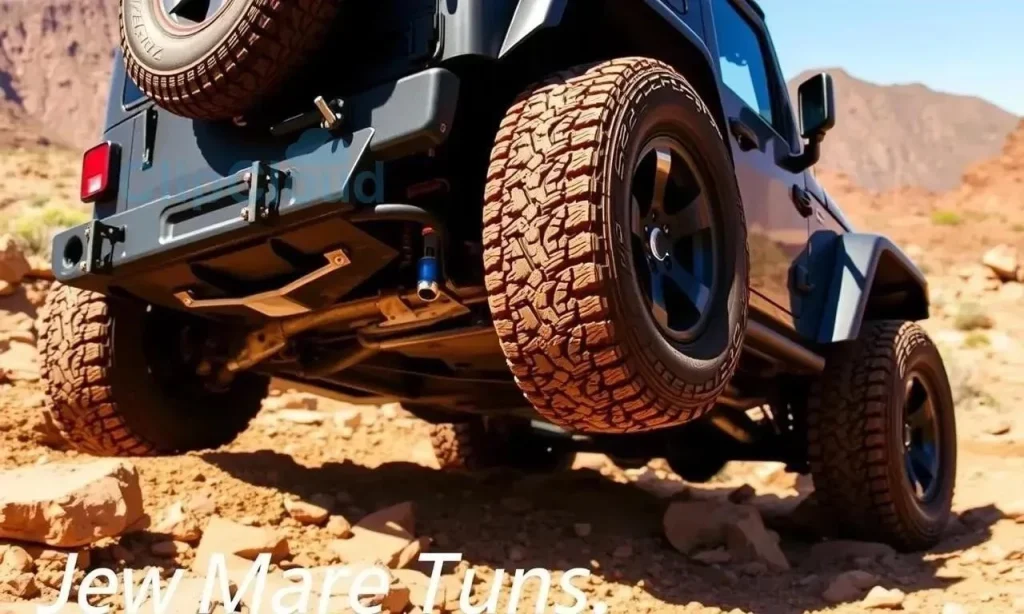Top 5 Tire Recommendations for Jeep Wranglers
Ready to conquer any terrain? Discover the top 5 Jeep Wrangler tire choices for killer off-road adventures and smooth highway rides. Find your perfect match now!

Choosing the right tires for your Jeep Wrangler is crucial for optimizing its performance both on and off-road. Your tires are the only point of contact between your Jeep and the ground, making them a critical factor in handling, traction, and overall driving experience. With a vast array of options available, selecting the ideal set can feel overwhelming. This guide will explore five of the best tire options for your Jeep Wrangler, helping you navigate the market and find the perfect fit for your needs and adventures.
Understanding Your Tire Needs
Before diving into specific tire recommendations, consider the following factors to determine the best fit for your Jeep Wrangler:
- Driving Style: Do you primarily drive on paved roads, or do you frequently venture off-road?
- Terrain: What type of terrain do you encounter most often (e.g., mud, rocks, sand)?
- Climate: Do you live in an area with snow, ice, or heavy rain?
- Budget: How much are you willing to spend on a set of tires?
- Goodyear Wrangler Duratrac: A popular choice known for its aggressive tread pattern, providing excellent traction in mud, snow, and on rocky terrain.
- BFGoodrich All-Terrain T/A KO2: A versatile all-terrain tire offering a great balance of on-road comfort and off-road capability.
- Nitto Ridge Grappler: A hybrid tire that combines the features of a mud-terrain and all-terrain tire, delivering impressive performance in various conditions.
- Cooper Discoverer STT Pro: An aggressive mud-terrain tire designed for extreme off-road adventures, providing exceptional grip in mud and on rocks.
- Falken Wildpeak A/T3W: A well-rounded all-terrain tire offering excellent performance in wet, dry, and snowy conditions, along with a comfortable ride.
Comparative Table: Top Tire Features
| Tire | Terrain Type | On-Road Comfort | Off-Road Traction | Snow Performance |
|---|---|---|---|---|
| Goodyear Wrangler Duratrac | All-Terrain/Mud-Terrain | Good | Excellent | Excellent |
| BFGoodrich All-Terrain T/A KO2 | All-Terrain | Very Good | Very Good | Good |
| Nitto Ridge Grappler | Hybrid (All-Terrain/Mud-Terrain) | Good | Excellent | Good |
| Cooper Discoverer STT Pro | Mud-Terrain | Fair | Excellent | Good (with siping) |
| Falken Wildpeak A/T3W | All-Terrain | Very Good | Good | Excellent |
H3: Choosing the Right Size
Ensuring you select the correct tire size is paramount for safety and performance. Consult your Jeep Wrangler’s owner’s manual or the tire placard on the driver’s side doorjamb for the recommended tire size. You can also use online tire size calculators to explore alternative sizes if you’re considering modifications.
H3: Professional Installation Recommended
While some Jeep owners may choose to install tires themselves, professional installation is generally recommended. Tire shops have the necessary equipment and expertise to properly mount, balance, and align your tires, ensuring optimal performance and safety;
FAQ: Frequently Asked Questions
Q: How often should I rotate my Jeep Wrangler tires?
A: It is generally recommended to rotate your tires every 5,000-8,000 miles to promote even wear and extend their lifespan.
Q: What is the proper tire pressure for my Jeep Wrangler?
A: Refer to the tire placard on the driver’s side doorjamb for the recommended tire pressure for your specific Jeep Wrangler model and tire size. Always check and adjust tire pressure when the tires are cold.
Q: Can I mix different tire brands or types on my Jeep Wrangler?
A: It is strongly discouraged to mix different tire brands or types, as this can negatively impact handling, stability, and braking performance. Always replace all four tires with the same brand, model, and size.
Q: How do I read the sidewall markings on a tire?
A: The sidewall markings provide important information about the tire, including its size, load capacity, speed rating, and manufacturing date. Numerous online resources and guides can help you decipher these markings.
Q: What is the difference between Load Range C, D, and E tires?
A: Load Range indicates the tire’s load-carrying capacity. Higher load ranges (e.g., E) are designed for heavier vehicles and loads, while lower load ranges (e.g., C) are suitable for lighter vehicles. Choose the appropriate load range based on your Jeep Wrangler’s weight and intended use.
Maintaining Your Tires for Longevity
Proper tire maintenance is key to maximizing the lifespan of your tires and ensuring optimal performance. Here are a few essential tips:
- Regular Tire Pressure Checks: Check your tire pressure at least once a month, and before any long trips. Use a reliable tire pressure gauge and adjust the pressure to the recommended level.
- Inspect for Wear and Damage: Regularly inspect your tires for signs of wear, such as uneven tread wear, cuts, bulges, or embedded objects. Address any issues promptly to prevent further damage or potential tire failure.
- Proper Alignment: Ensure your Jeep Wrangler’s wheels are properly aligned. Misalignment can lead to uneven tire wear and handling problems. Get a wheel alignment check at least once a year, or whenever you notice steering issues.
- Balance Your Tires: Balanced tires provide a smoother ride and prevent vibrations. Have your tires balanced whenever you get them rotated.
- Store Tires Properly: If you’re storing tires, keep them in a cool, dry, and dark place. Protect them from direct sunlight and extreme temperatures. Stack them horizontally to prevent distortion.
When to Replace Your Tires
Knowing when to replace your tires is crucial for safety. Here are some indicators that it’s time for a new set:
- Tread Wear: Check the tread depth using a tread depth gauge or the penny test (insert a penny upside down into the tread groove; if you can see the top of Lincoln’s head, the tread is too low). Replace tires when the tread depth reaches 2/32 of an inch.
- Visible Damage: Replace tires with any significant cuts, bulges, or sidewall damage.
- Age: Even if the tread depth is still adequate, tires can degrade over time. Check the manufacturing date code on the tire sidewall. Most manufacturers recommend replacing tires after six to ten years, regardless of tread depth.
- Vibrations or Handling Issues: If you experience excessive vibrations, difficulty steering, or other handling problems, it could indicate tire damage or wear. Have your tires inspected by a professional;
Understanding Tire Load Ratings
The load rating on a tire indicates the maximum weight it can safely carry. Exceeding the load rating can lead to tire failure and dangerous driving conditions. Consult your Jeep Wrangler’s owner’s manual or the tire placard to determine the appropriate load rating for your vehicle. When choosing replacement tires, ensure they have a load rating that meets or exceeds the original specifications.
The Importance of Tire Pressure Monitoring Systems (TPMS)
Many modern Jeep Wranglers are equipped with a Tire Pressure Monitoring System (TPMS). This system alerts you when your tire pressure is significantly low. Pay attention to TPMS warnings and promptly address any pressure issues. Maintaining proper tire pressure improves fuel efficiency, extends tire life, and enhances safety.
Final Thoughts: Invest in Quality and Safety
Choosing the right tires for your Jeep Wrangler is an investment in your vehicle’s performance, safety, and overall driving experience; Take the time to research your options, consider your driving needs, and prioritize quality and reliability. By following these guidelines, you can confidently select a set of tires that will conquer any terrain and provide years of dependable service.
Beyond the Basics: Exploring Tire Technology
The world of tires is constantly evolving, with manufacturers incorporating advanced technologies to improve performance, safety, and fuel efficiency. Understanding some of these technologies can help you make a more informed decision when choosing tires for your Jeep Wrangler. Some key features to consider include:
- Silica Compounds: These compounds are added to the tire’s rubber mixture to improve wet traction and reduce rolling resistance, leading to better fuel economy.
- Advanced Tread Patterns: Tire manufacturers are developing intricate tread patterns that enhance grip in various conditions, from dry pavement to mud and snow. Look for tires with aggressive tread designs for off-road use.
- Reinforced Sidewalls: Reinforced sidewalls provide extra protection against punctures and cuts, particularly important for off-roading.
- Run-Flat Technology: Some tires feature run-flat technology, allowing you to drive a limited distance even after a puncture. This can be a valuable safety feature, especially in remote areas.
- Noise Reduction Technology: Certain tire models incorporate noise reduction technology to minimize road noise, providing a more comfortable driving experience.
Seasonal Tire Considerations
Depending on your location and the prevailing weather conditions, you might consider using different tires during different seasons. While all-terrain tires are a popular choice for Jeep Wranglers, they may not provide optimal performance in extreme winter conditions. In areas with heavy snowfall and ice, dedicated winter tires can offer significantly better traction and control.
Winter tires feature a special rubber compound that remains flexible in cold temperatures, along with a unique tread pattern designed to grip snow and ice. Consider swapping to winter tires in the fall and switching back to all-terrain or all-season tires in the spring.
The Impact of Lift Kits and Modifications on Tire Choice
If you’ve installed a lift kit or made other modifications to your Jeep Wrangler, you’ll need to consider how these changes affect your tire choice. Lift kits create more clearance, allowing you to fit larger tires. However, it’s crucial to ensure that the larger tires don’t rub against the fenders or suspension components. Consult with a qualified mechanic or tire specialist to determine the appropriate tire size for your modified Jeep Wrangler.
Staying Informed About Tire Recalls
From time to time, tire manufacturers may issue recalls due to safety concerns. It’s essential to stay informed about tire recalls and take action if your tires are affected. You can check for recalls on the National Highway Traffic Safety Administration (NHTSA) website or by contacting the tire manufacturer directly. If your tires are subject to a recall, follow the manufacturer’s instructions for replacement.
Don’t Neglect the Spare Tire
Finally, don’t forget about your spare tire! Ensure that your spare tire is in good condition and properly inflated. If your Jeep Wrangler has a full-size spare, rotate it into your regular tire rotation schedule to ensure even wear. If you have a temporary spare, familiarize yourself with its limitations and usage instructions.
By taking these factors into account, you can make an informed decision when choosing tires for your Jeep Wrangler and enjoy a safe and rewarding driving experience, both on and off the road.




